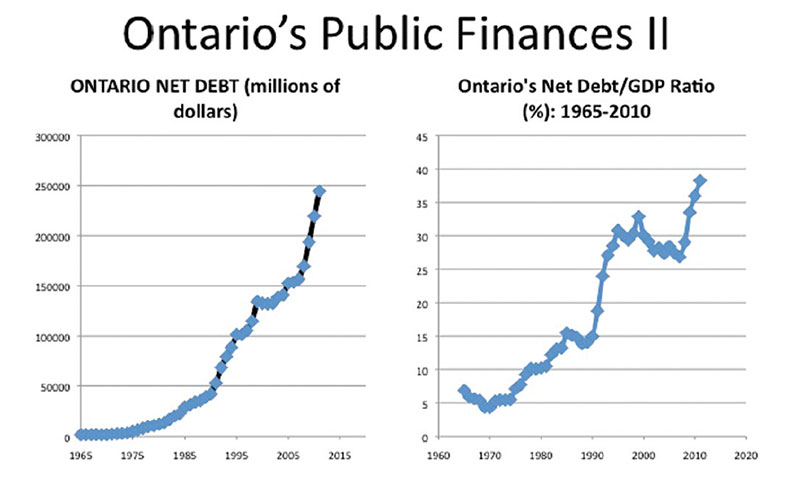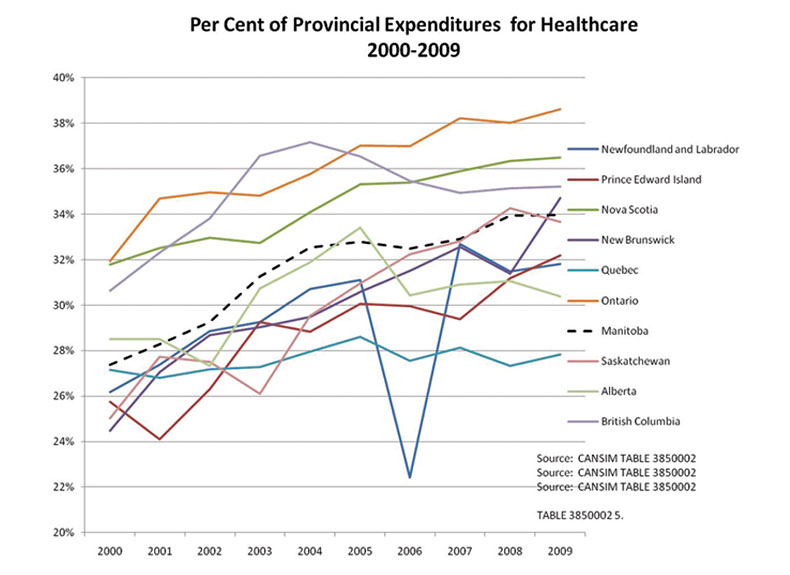And now for something completely different…in mid- February economist Don Drummond delivered his report for the Ontario Government outlining the measures that would be required for that province to get their deficit under control. Why does this matter to us? Well, much as we have seen with the Euro debt crisis with Greece leading the way, a number of other European countries are not far behind in the debt overload situation. So for other Provinces in Canada, Ontario may well be the harbinger of things to come. And the one area that all Canadians hold most dear – that of healthcare – is the single biggest expenditure in each provincial jurisdiction.
Ontario’s cumulative debt is currently at around $236 billion. For comparison Canada’s Federal debt is around $558 billion. Bob Rae was the NDP Premier of Ontario from 1990 to 1995. He has the infamous legacy of doubling their deficit from $50 billion to a cumulative amount of $100 billion while in office. However since then, the Premiership of Ontario has been held by both the Conservatives and the Liberals.

Certainly, over the past number of years, the downturn in the global and US economies have hurt their manufacturing sectors. This sluggish revenue and an aging population causing healthcare costs to continue to rise have made it difficult to curtail the continuing year over year deficits. This past fiscal year report showed another $14 billion deficit and the upcoming year (all things being equal) anticipates another $16 billion dollar deficit.
“I think the Drummond report could serve as a blueprint for fiscal reform across the country,” said Mark Milke of the Vancouver-based Fraser Institute. “Look, Ontario is the biggest province, obviously. What Ontario does matters.” Last December, ratings agency Moody’s lowered the province’s outlook from “stable” to “negative” and warned Ontario needed to take drastic measures to control its expanding debt load.
Ontario must implement all of the hundreds of recommendations laid out in a massive cost-cutting plan if it wants to “just make” its target of eliminating a projected $30.2-billion deficit by 2017-18, warns economist Don Drummond. “This is not a smorgasbord from which the government can choose only the tastiest morsels and ignore the less palatable,” says the highly anticipated report released by the former chief economist with TD bank. Unless the government acts on all 362 proposals—ranging from reforming how it delivers healthcare services to raising classroom sizes—it will find itself in a similar situation as debt-ridden Greece, said Drummond.
Healthcare, in any given electoral issue poll, is the single most important issue to Canadians. In 1996, when faced with a large budget shortfall, the Liberal federal government merged the health transfers with the transfers for other social programs into the Canada Health and Social Transfer, and overall funding levels were cut. This placed considerable pressure on the provinces, and combined with population aging and the generally high rate of inflation in health costs, has caused problems with the system.
The percentage of healthcare expenditures out of total expenditures vary from Province to Province but it is safe to say the average has surpassed 35 %. In Alberta, our latest budget for 2012-13 puts healthcare spending at 40 % of the total budget. Ontario is currently sitting at about 44 % of total budget.

Life expectancy in Canada is somewhere above 81 years of age (+/- 2 years depending upon gender). Certainly as our population ages and lives longer healthcare costs will increase. As well there are more people out of the working population no longer paying taxes for the most part.
Finance Minister Jim Flaherty announced in December the 10- year health funding arrangement with the provinces. It takes effect in 2014 and will maintain the annual increase in the transfers at six per cent until 2016-17. After that, the government will then link health-care funding increases to the rate of the country’s economic growth including inflation — which is roughly four per cent — costing the provinces billions of dollars. The Parliamentary Budget Office (PBO) expects health transfers to the provinces to grow at 3.9 per cent annually, on average, from 2017-18 to 2024-25. That is “significantly lower” than the agency’s projected growth in provincial-territorial health spending over the same period—which is expected to reach 5.1 per cent average annual growth. Under this plan the financial health of the provinces will only worsen—forcing provincial and territorial governments to either raise taxes to generate more revenue, or cut programs and services.
Our current system largely purports to be a 70/30 split between publicly funded healthcare and various private things we pay for ourselves (out-of-pocket payments, private insurance) for a variety of health services including hospitals, physicians, prescription drugs and dental and vision care. The debate is most certainly mired in ideology. Canada actually spends quite a bit less per capita than the USA ($3845 vs. $7290). They too face challenging times ahead with control of their cost structures in the face of new Government policies such as Obamacare. There really isn’t any easy answer to this one. Someone somewhere at some point in time will have to move from debate to action that, either way, will represent an unpopular stance by the public in general.
From the Thursday Files
The sooner you fall behind, the more time you’ll have to catch up.
– Wright











Share This Column